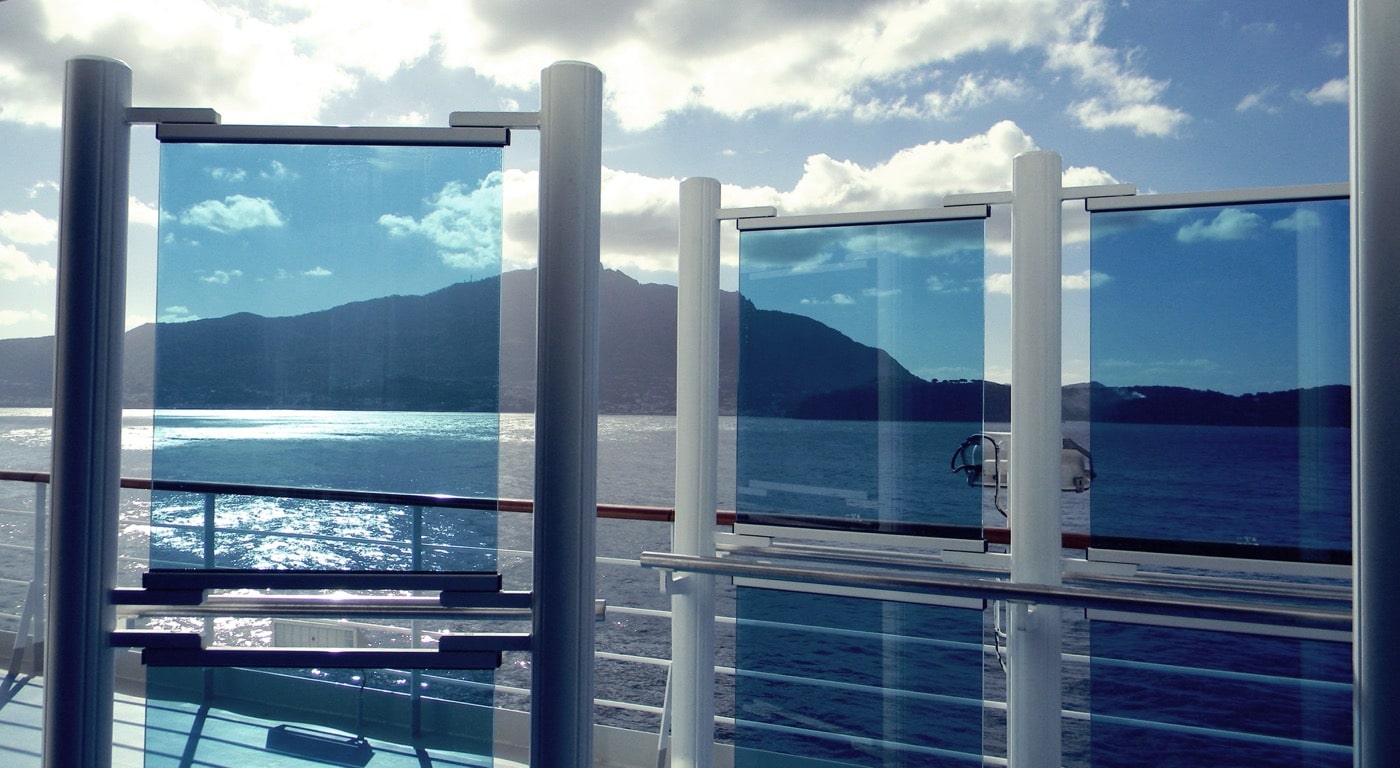In many ways, Italy is a boot that fits all feet. From top to bottom it’s possible to ski the Dolomites, take in Florence’s finest art, roam the ruins of Pompeii, and island hop the Amalfi Coast. Despite its troubled economy, Italy remains a top destination and is teeming with tourists practically everywhere, a fact that can easily detract from the pleasure of visiting. Still, there are areas that are off the beaten track and embody an old world charm that’s often missing when sneaking around the Sistine Chapel with a million other tourists. Ischia, a volcanic island to the northwest of Capri and the largest in the Bay of Naples, is one of those places.
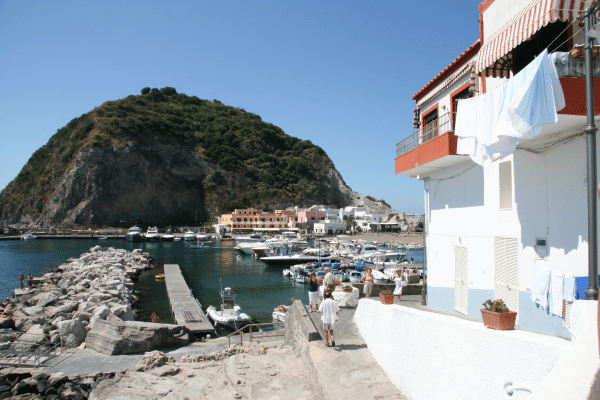
Located in the Tyrrhenian Sea, Ischia isn’t particularly well known outside of Europe. Thermal spas are its primary draw but during our long weekend, we discovered that the hot springs fed by dormant Mount Epomeo aren’t all that comprise this lovely oasis. Known as the Emerald Island due to an abundance of vineyards and lush greenery, it’s easily reached either by ferry or high-speed hydrofoil from ports in Naples, Pozzuoli, Procida, and Sorrento. You may elect to take a car onto the island or rent one during your stay, which should be a consideration as taxi rates are exorbitant and will have you longing for the days of the lira. Scooters are another economical choice and an easy way of navigating this mountainous island but otherwise we found the bus system to be relatively suitable most of the time. The island itself is divided into six townships: Barano, Casamicciola Terme, Serrara Fontana, Ischia (including Ischia Porto and Ischia Ponte), Forio, and Lacco Ameno, the latter three of which are where most of the tourists spend their time.
Pulling into Ischia Porto we were met by undulating hills, pastel Portofino-esque buildings, and a massive fortress to the west. A host of taxis awaited us (some of which were glorified three-wheeled tuk tuks) and while the hydrofoil was packed, we were immediately approached by an amiable, weathered man named Tonino who piled our bags into his van and commenced our three-day journey. As we rode along the coast I noted a rustic allure that I didn’t experience in Sorrento or Amalfi, an uncompromised authenticity that’s perhaps derived from the island’s 20-mile proximity to rough and tumble Naples. I also recalled that Cleopatra was filmed here in the early 1960’s when Elizabeth Taylor and Richard Burton embarked on their storied romance, and mused this wouldn’t be a bad place to begin an affair.
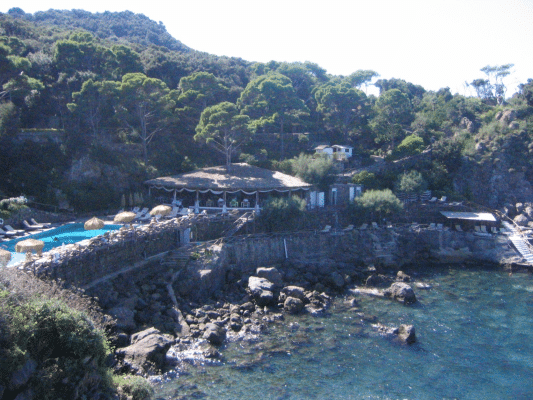
Our coastline drive soon morphed into a meandering crawl toward our hotel, the Mezzatorre Resort and Spa. Majestically perched on a bluff in Forio, the property consists of several buildings over 17 acres with a top-notch spa housed in a medieval watchtower. The latter is the hotel’s main building and while it’s without question the most striking, we found the best value to be in the Serra building where double rooms have patios coupled with views of the sea. The interiors are anything but grandiose, however, offering simpler schemes instead (terra cotta floors, lots of white) and the lighter hues enhance a pervasive sense of tranquility. There are two restaurants within the resort, the more refined Chandelier and the less formal Sciué Sciué, both of which will impress the discerning locavore. As for the staff, they’re just what you’d expect from one of the Leading Hotels of the World – gracious, genuine, and invariably on point. While waiting for our baggage to arrive, we were brought two Bellini’s and a plate of pastries. On Ischia, life is good.
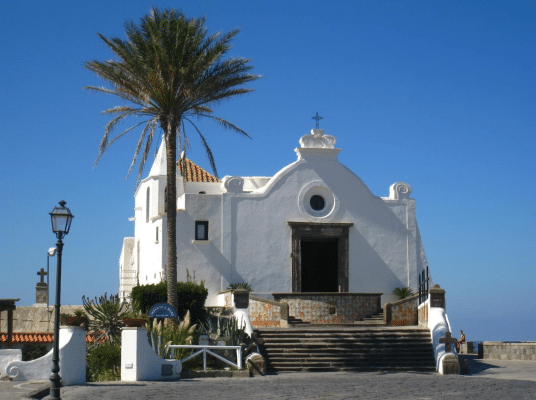
The hotel offers a complimentary shuttle service at various times throughout the day, so we hopped a ride down the mountain and grabbed a cab to Forio proper. I realized at this point that it might be worth bargaining with the taxi drivers – as I mentioned, they were rather pricey and I discovered that a bit of haggling usually led to five Euros being knocked off the mandated €20-30 fares. Within ten minutes we arrived in the Forio centre which was lined with restaurants, shops and bars, though we made it our first priority to visit the Santa Maria del Soccorso. One of the island’s most recognizable landmarks, the 14thcentury whitewashed church is dedicated to sailors who have survived shipwrecks (soccorso is Italian for “rescue”). Compared to other Italian monuments the interior is relatively modest housing a few statues, model ships, and nautical paintings. The exterior is far more charming – a semicircular staircase leads to the entry and decaying majolica tiles line both the base and adjacent walls. Even though Forio’s bustling streets are nearby, for a moment you’ll feel you’re at the edge of the earth when rounding the perimeter and soaking in the view of the infinite sea.
Next door is Umberto a Mare, an 11 room hotel established in the 1930’s that boasts an eponymous restaurant, one of the island’s best. As with most eateries on Ischia, the menu is dominated by catches of the day and a few pasta dishes. Standouts for dinner include an excellent aubergine casserole followed by “hamburger tuna” (a local take on tuna tartare) and risotto a mare. Likewise there’s a degustation menu for those wishing to linger over a longer meal while watching the sunset.
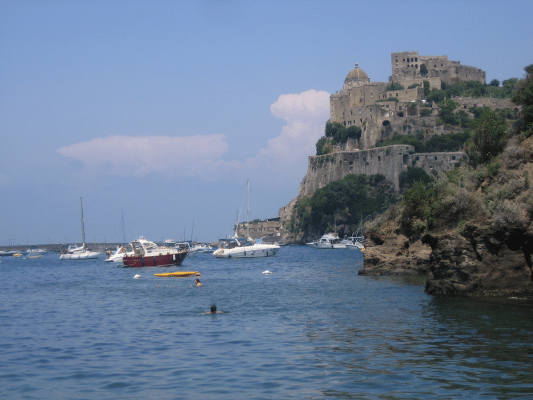
The next morning we ventured to the sleepy fishing village of Ischia Ponte to visit Castello Aragonese, the mammoth bastion I observed when pulling into port. The structure dates back to 5 B.C. when the Greeks first settled on Ischia, while much of the complex one sees today – ramparts, multi-level terraces, and flagstone patios – was constructed between the 14th to 17th centuries. Its name is derived from Alfonso V of Aragon who connected the castle to the rest of the island via a long, narrow bridge in the 15th century; prior to this the fortress was reachable only by boat as its primary purpose was staving off incursions. The vantage point provides an excellent spot for photo opps as it looks straight onto Ischia Ponte. As we passed through a tunnel and arduously climbed to the summit, I noted the number of churches within the confines; later I learned that as late as 1700, the castle was home to roughly 2000 inhabitants since it was the safest place to reside on the island. It’s possible to spend a few nights within the castle at Albergo Il Monastero, a former convent offering reasonable rooms in an aesthetically unique setting (some with terraces and/or sea views are worth a few extra Euros). The restaurant here is highly regarded though we opted to take the elevator down and stopped in at the nearby Ristorante da Ciccio, where we sat outside with a carafe of house wine admiring the imposing edifice from afar.
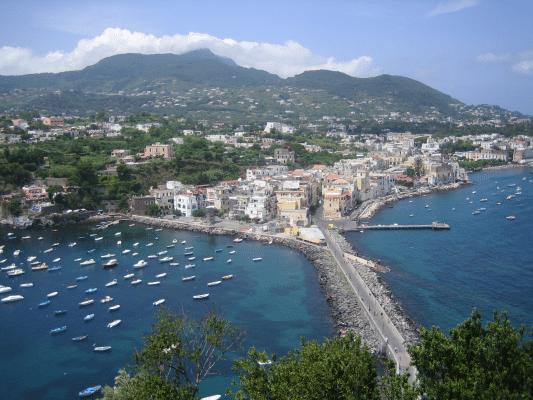
Many visitors to Ischia travel there exclusively for its spas. If you’re staying at the Mezzatorre, take full advantage of their facilities which include every thermo-mineral treatment imaginable along with Turkish baths, outdoor massages and volcanic mud services. Their day spa is open to visitors but if you’re seeking an option in town, I recommend the Poseidon Gardens Terme in Forio, an outdoor retreat that likewise has its own restaurants and a private section on the Citara beach. We opted for a cost-free experience that afternoon at Forio’s Bay of Sorgeto, a small inlet where open-air hot springs are accessed by descending 200 stone stairs; Ischiatans used to cook on the rocks there due to the boiling temperatures so be mindful when walking down. The cove is open at night, too, which is an advantage since it’s not only a cooler but not overrun with locals and tourists as it is during the day.
On our second evening we dined at Il Focolare and had the finest meal of our long weekend. Located high in the hills of the Barano township with a decidedly no frills décor (burlap sacks serve as curtains and movie posters of films shot in Ischia adorn the walls), the restaurant feels more like a relative’s home where you’re feasting on Sunday supper. Riccardo and Loretta D’Ambra opened Il Focolare in 1991 and their eight children round out the staff, with brothers Agostino and Francesco manning the kitchen. Agostino is a Cipriaini’s Downtown and Rainbow Room alum who was hired on the spot after a member of the Cipriani clan dined here years ago. Rabbit is his strong suit and requires advance notice so be sure to mention how many you’d like when your hotel makes a reservation. We split the specialty and in addition ordered lemon chicken, rotolino eggplant, and the best lemon tart I’ve ever eaten. Upon learning we hailed from New York, Agostino affably invited us to a cavernous cantina behind the kitchen where he spoke about his family’s history on Ischia as well as his time spent in Manhattan. (The D’Ambras have also produced wine locally since 1888 and a visit can be arranged to their vineyard by appointment.) After saying our goodbyes, we left Il Focolare sated in every possible way, and I realized this is the type of experience that can only be had when you’re truly an outsider.
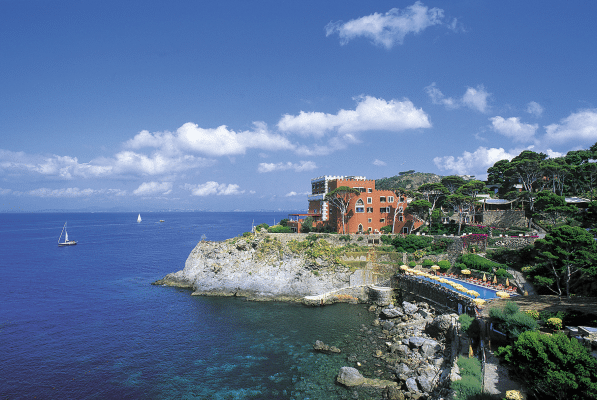
On our final morning we lazed about the Mezzatorre, enjoying its swimming cove that opens into the Mediterranean and dried off by exploring its sprawling grounds. Situated behind the property is famed director Luchino Visconti’s villa that has been transformed into a film school and museum known as La Colombaia. We were more interested in checking out the villa itself though the displays are certainly worth thirty minutes of your time. Afterward we headed to nearby Giardini La Mortella, an expansive set of tiered gardens where British composer Sir William Walton resided with his wife, Susana. Susana developed the gardens with landscape architect Russell Page as she wanted to create a sanctuary where her husband could compose in peace. She had tropical plants flown in from around the world and the sun-dappled gardens are replete with fountains, a Thai pavilion, tea house, and Greek amphitheater where concerts are held with the breathtaking Bay of Forio as a backdrop.
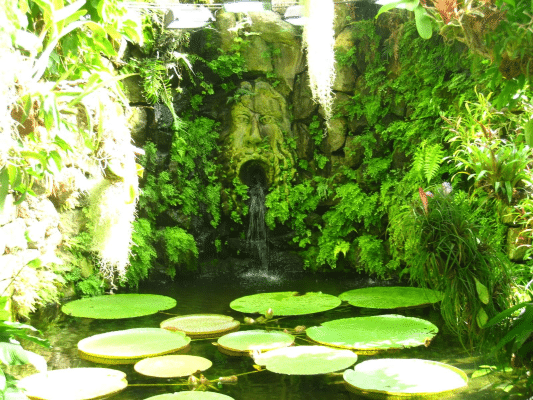
The one part of the island that we hadn’t visited at this point was Sant’Angelo, a small fishing village with a pedestrian-only zone where we perused a few art galleries and boutiques that tumbled down to the water. The shoreline here isn’t as crowded as other parts of the island and given its size, the Chiaia di Rose beach feels private (though everyone else seems aware of that during the daytime). We climbed a precipitous set of stairs to Da Pasquale, a small eatery run by the Iacono family who serve an array of inexpensive pizzas and ripieno, a sort of calzone with various fillings. The stuffed pepper with meat and capers shouldn’t be missed and the pastas appeared relatively appetizing. Our last meal on the island seemed to symbolize what distinguishes Ischia most from some of the more trafficked of Italy’s islands – the best things are family-run, down to earth, and make you feel like you’re part of the culture.
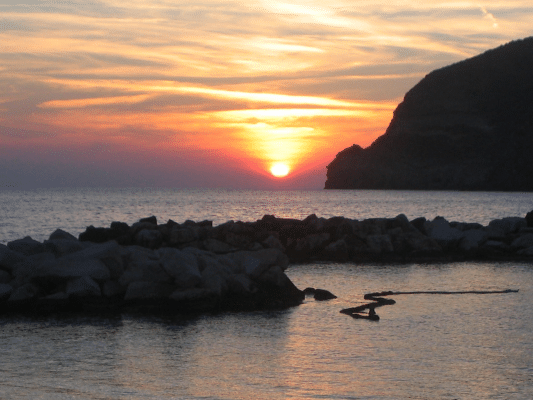
Following dinner we walked to the beach where I watched the sands being meticulously raked for tomorrow’s sunbathers, and listened to schoolchildren shout at one another as they kicked a soccer ball back and forth – even yelling has a mellifluous cadence in Italian. The sun began to set and it didn’t appear that anyone else but us took notice, and I felt as though this was yet another moment I could call my own while on this Emerald Island.
The country code for Italy is 39.
Where to Stay:
Mezzatorre Resort & Spa
Via Mezzatorre 23, 80075 Forio
+39 081 986111
Alberto Il Monastero
Aragonese Castle, 80077 Ischia
+39 081 992435
L’Albergo della Regina Isabella
Piazza Santa Restituta 1, 80076 Lacco Ameno
+39 081 994322
Grand Hotel Excelsior Terme
Via Emanuele Gianturco 19, 80077 Ischia
+39 081 991522
Piccolo Hotel Umberto a Mare
Via del Soccorso 2, 80075 Forio
+39 081 997258
Where to Eat:
Ristorante Umberto a Mare
Via del Soccorso 2, 80075 Forio
+39 081 997258
Il Focolare
Via Cretajo al Crocefisso 3, 80074 Barano
+39 081 902944
Ristorante Da Ciccio
Via Luigi Mazzella 32, 80077 Ischia
+39 081 991686
(no website)
Ristorante Pizzeria da Pasquale
Via S. Angelo 79, 80070 Sant’Angelo
+39 081 904208
Il Mosaico (in the Terme Manzi Hotel & Spa)
Piazza Bagni 4, 80074 Casamicciola Terme
+39 081 994722
www.termemanzihotel.com/mosaico-restaurant&lang=en
What to See and Do:
Santa Maria del Soccorso
Via Soccorso, 80075 Forio
Castello Aragonese
Via Pontile Aragonese, 80077 Ischia
+39 081 992834
www.castelloaragoneseischia.com
Poseidon Gardens Terme
Via Giovanni Mazzella 87, 80075 Forio
+39 081 9087111
Fondazione La Colombaia di Luchino Visconti
Via Francesco Calise 142, 80075 Forio
+39 348 5127762
(Open April 18th through November 3rd, 10am-1pm / 3:30pm to dusk, closed Mondays)
Bay of Sorgeto
www.visitischia.com/en/spiaggia-di-sorgeto.html
Giardini La Mortella
Via Francesco Calise 39, 80075 Forio
+39 081 986220
www.lamortella.org (***link has to be pasted into browser)
(Open April 1st through November 2nd Tuesday, Thursday, Saturday, and Sunday from 9am to 7pm)
Casa D’Ambra
Via Mario D’Ambra 16, 80075 Forio
+39 081 907246
Reservations for vineyard tours are required; contact info@dambravini.com at least two weeks in advance
Useful Links:
Hydrofoil Information and Schedules –
Car Rental –
Autonoleggio Auto & Scooter
Via Iasolino 24, 80077 Banchina Olimpica Porto d’Ischia
+39 081 985720

